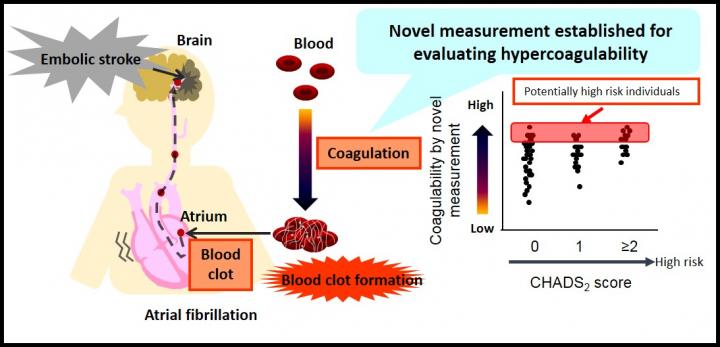Blood coagulation detector may help in monitoring stroke risk

Assessing embolic stroke risk by measuring blood coagulability. Credit: Department of Biofunctional Informatics, TMDU
Atrial fibrillation (AF) causes an irregular and sometimes fast heart rate, and is a common risk factor for stroke. To estimate this risk in AF patients and determine the requirement for anticoagulation therapy, the CHADS2 predictive score is used.
Because some parts of this score are also associated with atherosclerosis risk and increased blood coagulability, a high score has been proposed as linked to hypercoagulability (an increased tendency for blood clotting) in both AF and non-AF patients. However, this association has not been fully investigated, partly owing to the lack of a sensitive means of detection.
A research team from TMDU used a highly sensitive technique to measure small changes in blood coagulation, and found hypercoagulability in non-AF patients with high CHADS2 scores. The study was recently reported in PLOS ONE.
Several physical and chemical factors affect blood clotting, some of which can be measured over time to determine blood coagulability and the likelihood of clot formation. Dielectric blood coagulometry (DBCM) is a recently developed test that measures changes in the dielectric permittivity of whole blood, representing clumping of red blood cells.
The researchers used DBCM to detect changes in the dielectric permittivity of whole blood at 10 MHz. Comparisons between untreated blood and that with added heparin (a blood thinner) or tissue factor (a blood-clotting accelerator) enabled derivation of a coagulability index.
“We calculated the end of acceleration time (EAT) as an index of coagulability from temporal changes in dielectric permittivity,” coauthor Satomi Hamada says. “This value reduced when tissue factor was added, and increased with heparin present. It was also sensitive enough to detect small changes in coagulability, particularly in hypercoagulability.” EAT also boasts high reproducibility and reliability.
The researchers found that patients receiving warfarin had a significantly longer EAT than those without, confirming the anticoagulation effect. They also showed that patients with a high CHADS2 score had a significantly shorter EAT that represented hypercoagulability compared with patients with lower CHADS2 scores. “Intriguingly, EAT varied widely in patients with CHADS2 scores of 0 or 1,” lead author Yuki Hasegawa says. “This suggests that DBCM can identify high risk of thrombosis even in patients with low CHADS2 scores.”
###
The article, “Novel dielectric coagulometer identifies hypercoagulability in patients with a high CHADS2 score without atrial fibrillation” was published in PLOS ONE at DOI:10.1371/journal.pone.0156557
Media Contact
All latest news from the category: Health and Medicine
This subject area encompasses research and studies in the field of human medicine.
Among the wide-ranging list of topics covered here are anesthesiology, anatomy, surgery, human genetics, hygiene and environmental medicine, internal medicine, neurology, pharmacology, physiology, urology and dental medicine.
Newest articles

Recovering phosphorus from sewage sludge ash
Chemical and heat treatment of sewage sludge can recover phosphorus in a process that could help address the problem of diminishing supplies of phosphorus ores. Valuable supplies of phosphorus could…

Efficient, sustainable and cost-effective hybrid energy storage system for modern power grids
EU project HyFlow: Over three years of research, the consortium of the EU project HyFlow has successfully developed a highly efficient, sustainable, and cost-effective hybrid energy storage system (HESS) that…

After 25 years, researchers uncover genetic cause of rare neurological disease
Some families call it a trial of faith. Others just call it a curse. The progressive neurological disease known as spinocerebellar ataxia 4 (SCA4) is a rare condition, but its…





















